Income requirements to qualify for a mortgage

Key takeaways
- There are no specific income requirements to qualify for a mortgage — but mortgage lenders do evaluate whether your income suffices to repay the amount you want to borrow.
- To determine if you’ll qualify, mortgage lenders review your debt-to-income (DTI) ratio, credit score and other factors.
- Some mortgages, like HomeReady and Home Possible conventional loans, impose income limits. You’ll be ineligible if your income exceeds a certain threshold.
From conventional to government loans, there are many types of mortgages to suit borrowers with varying credit scores and financial means. There is no standard baseline income required to qualify for a mortgage, but your lender will want to ensure you make enough to repay your loan.
Here’s how your income can impact your ability to qualify for a mortgage.
Are there income requirements for a mortgage?
There is no single, universal income requirement to qualify for a mortgage. It all depends on the type of loan you’re seeking, the amount you need to borrow and current interest rates.
Rather than requiring a specific amount of income, mortgage lenders review your credit history, your debt-to-income (DTI) ratio and other information about your cash flow to figure out if you can afford the mortgage you want.
Debt-to-income ratio requirements for a mortgage
To calculate your DTI ratio, divide your monthly debt payments by your gross monthly income.
While there’s no minimum income requirement for a mortgage, your income does influence your DTI ratio. Lenders’ requirements for that ratio vary by loan type:
- Conventional loans: No more than 36 percent, but can go up to 50 percent with “compensating factors,” like a bigger down payment, higher credit score or adequate reserves
- FHA loans: No more than 43 percent
- VA loans and USDA loans: No more than 41 percent
Let’s say you have a monthly income of $6,000. Your debts include a $300 student loan payment, a $200 car payment, a $100 minimum credit card payment, and if approved for your mortgage, a $1,900 housing payment. To calculate your DTI, you’d divide your monthly debt payments by your monthly income.
Debts: $300 + $200 + $100 + $1,900 = $2,500
Income: $6,000
$2,500 / $6,000 = 41.66 percent
In this scenario, your DTI is just over 41 percent. That means you’d be eligible for an FHA loan and right on the cusp of qualifying for a VA or USDA loan.
To qualify for a conventional loan, you’d either need to increase your income by $1,000 per month or meet some of those compensating factors.
What sources of income qualify for a mortgage?
You can use many different income sources to qualify for a mortgage, including:
- Employment income: Base pay or wages, bonuses, commissions, overtime payments and self-employment income
- Schedule K-1: Income and distributions from partnerships, S corporations and estates
- Retirement income: Income from retirement accounts (like a 401(k), IRA or 403(b)) and pension income
- Rental income (including from accessory dwelling units, or ADUs)
- Disability payments
- Social Security payments
- Dividend or interest income
- Alimony and child support
- Trust income
Whichever type of income you have, you’ll need to give your lender documentation to support your claims. Here’s a list of common documents needed for a mortgage.
How much of your income should go toward mortgage payments?
When you’re determining how much of your income should go toward your housing costs, most financial advisors recommend following the 28/36 rule. This means your monthly mortgage payment and total monthly debts shouldn’t exceed 28 and 36 percent of your total gross income, respectively.
For example, if your gross income is $6,000 per month, your mortgage payment should be no more than $1,680 (28 percent of $6,000), and your total debt payments (including the mortgage) should max out at $2,160 (36 percent of $6,000). Use Bankrate’s calculator to see how much house you can afford.
Learn more: How much house can I afford on a $100K salary?
Other factors that impact mortgage qualification
Beyond your income and DTI ratio, lenders also review your:
- Employment record: The requirements vary by lender, but typically, you’ll need to provide evidence of steady employment from the past two years.
- Credit score: For a conventional loan, you’ll need at least a 620 FICO score. If you don’t qualify, you might consider an FHA loan, which allows scores as low as 580. The higher your score, the better the interest rate lenders will offer you.
- Credit history: Lenders are interested in your credit history in addition to your credit score. This helps them determine whether you routinely make late payments or have any foreclosures or bankruptcies on your record.
- Down payment: For a conventional loan, the down payment requirement can be as low as 3 percent. FHA loans require 3.5 percent, while VA and USDA loans typically don’t require a down payment. Like your credit score, the higher your down payment, the more likely the lender will offer you a better rate.
- Cash reserves: This isn’t a firm requirement, but some lenders want to see that you have enough savings and liquid assets to cover mortgage payments for several months.
- Collateral: Collateral is another important factor lenders consider for mortgage qualification. Collateral represents the value of the asset that secures your mortgage loan (in this case, the home you’re purchasing), which lenders use to determine how much they’re willing to lend. If you fail to make mortgage payments as agreed, the lender can initiate foreclosure, which involves taking possession of the home.
“Speaking from personal experience, I switched jobs two months before applying for a mortgage,” says Andrew Dehan, writer at Bankrate. “One lender required that I submit multiple extra pay stubs. It also pushed my partner to leave me off the mortgage because she had the higher credit score and had been at her job longer. We shopped around and found a lower rate at a bank that didn’t give us nearly as much trouble.”
Low-income loan options for mortgages
While there’s no one income required to buy a house, there are certain programs that help lower-income buyers which actually have income qualification limits. For instance, some low-income loan programs, such as Fannie Mae’s HomeReady program, are only open to applicants who make no more than 80 percent of your area’s median income (AMI). That would mean if the median annual income in the community where you live is $80,000, you can make no more than $64,000 to meet the HomeReady income limits.
Consider these ways to buy a house with low income:
- Conventional loan programs: Fannie Mae and Freddie Mac back two conventional mortgages for lower-income borrowers: HomeReady and Home Possible, respectively. The minimum down payment is 3 percent.
- HFA loans: These are loans offered through state housing finance agencies (HFAs). Often they’re geared toward lower- to moderate-income borrowers and have low down payment requirements, competitive interest rates and include closing cost or down payment assistance.
- FHA loans: Insured through the Federal Housing Administration, FHA loans have more lenient credit score and DTI ratio requirements than conventional mortgages. The minimum down payment is 3.5 percent.
- VA and USDA loans: Both of these government-guaranteed loans have no down payment requirement for those who qualify.
In addition to low-income loan options, there are down payment assistance programs specifically designed for lower-income buyers. The majority of these also have income limits, but it’s important to note that these vary widely: What constitutes a low income in San Francisco looks a lot different than it does in San Antonio, for example.
Learn more: What does it take to get a no-down-payment mortgage?
FAQ
Why we ask for feedback Your feedback helps us improve our content and services. It takes less than a minute to complete.
Your responses are anonymous and will only be used for improving our website.







